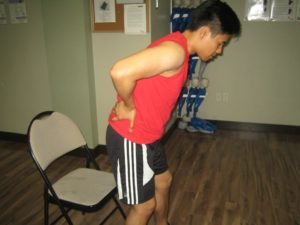A herniated disc injury can occur in any location along the spine but often occurs in the lower back since this is where most of the body weight is supported. The injury usually involves the rupture of one or several spinal discs. Depending on the injury, all or part of the nucleus pulposus which is the shock-absorbing material is thrusted out of the disc.
Oftentimes, the herniated nucleus pulposus lands on a nerve root in the rear part of the spine. Once this occurs, it will trigger intense pain. Depending on the level of the spine that is affected, other symptoms can manifest such as weakness, numbness or an electrical shock sensation radiating down the leg or arm. When a herniated disc involves a spinal nerve root, the symptoms that manifest are called radiculopathy.
What are the signs and symptoms?
The indications of a herniated disc tend to vary depending on the site. Essentially, there might be one or several radicular symptoms.
An individual will experience radicular symptoms spreading down an arm or leg since the spinal nerve roots divide into the nerves that travel throughout the body. Remember that every nerve root is designated with a particular region of the body to where it sends sensations and movement impulses.
Possible causes and risk factors

A herniated disc usually affects men between 30-50 years old particularly those with physical occupations. The injury occurs less frequently among the elderly since the discs eventually dry out. The older individuals have the tendency to develop degenerating discs rather than a herniated disc. The main causes of a herniated disc include the following:
- Disc deterioration
- Compression and/or loading of the spine when bent forward
- Trauma or injury especially those that involve significant micro trauma over time
How a herniated disc is diagnosed?
When diagnosing the injury, the doctor will take the medical history and conduct a physical exam. The individual is asked to describe his/her symptoms in detail.
The doctor will evaluate the spinal alignment, muscle strength and reflexes. The sensations are carefully checked at every dermatome. By locating the symptoms that affect the spinal nerve root in the dermatome, the doctor can trace the symptoms to the precise spinal nerve root or roots that are affected.
Treatment
Even though discectomy is often effective in alleviating the pain due to a herniated disc, waiting it out with physical therapy might be an alternative. A doctor should be consulted to determine the suitable measure.
The non-surgical treatment for a lumbar herniated disc usually includes rest, pain medications, muscle relaxants and/or anti-inflammatory medications, epidural steroid injection and/or physical therapy. The objective is to reduce the pain or discomfort from the irritated nerve roots and help the individual get into better shape. Additionally, conditioning the muscles can also protect the back as well as allow the individual to engage in physical activity with minimal pain.
